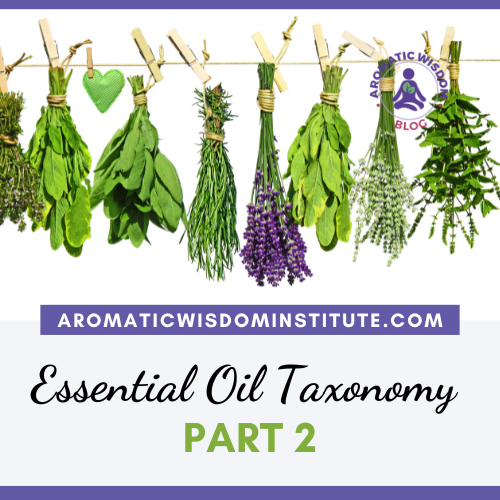In my last post, Essential Oil Taxonomy and Nomenclature: Part 1, we learned the meaning of the words taxonomy and nomenclature. We learned that essential oils are named after their plant source and many plants are given several “common names”, thus creating confusion when you purchase an essential oil by common name alone.
Knowing the Latin name will clarify exactly what essential oil we’re talking about. The Genus and the Species make up the Latin name or “Latin binomial”. The Latin name is always italicized, so it will look something like this: Lavender, Lavendula angustifolia.
Isn’t this fun?
Now that you have a feel for the Genus and Species, let’s talk about four other aspects you will see in Latin names
(you’ll be amazed how smart you feel when you know this!)
1. Variety
2. Chemotypes
3. Hybrid
4. Clone
 1# VARIETY (also called “Var.” or “Forma”) – Using the “family” metaphor, this would refer to fraternal twins (with some distinguishing physical features).
1# VARIETY (also called “Var.” or “Forma”) – Using the “family” metaphor, this would refer to fraternal twins (with some distinguishing physical features).
Variety: Same genus and species but the plant has some distinguishing physical characteristics (like flower color). Example: citrus aurantium var. amara.
Different citrus aurantium trees exist; the one we get Neroli from is var. amara.
#2 CHEMOTYPE– Sometimes in aromatherapy you will come across two or more essential oils with the same Latin name (same genus and species) and different chemical profiles. The plants look exactly alike yet they smell different and have a different chemistry. This is a cool and mysterious fact of nature.
Chemotypes are produced by certain plants (like Thyme –Thymus vulgaris). These plants produce, from a single species, different essential oils! The plants look identical but the chemical constituents vary considerably from plant to plant—as does the aroma. This occurs due to genetic and environmental factors. Sometimes the plant is adapting by becoming resistant to local pests and diseases, other times the plant adapts to the soil, altitude, amount of rainfall, and other environmental factors. This is another reason that it is vital to have a GC/MS report.
Due to the chemical variations, the different types of essential oils are called chemotypes (ct), or occasionally the term chemovars – (cv) is used. They are written as shown below, using ct. as an abbreviation for chemotype.
Some Examples of different chemotypes
– ROSEMARY: Salvia rosmarinus ct camphor (aka Rosmarinus officinalis ct. camphor)
– THYME ct linalol Thymus vulgaris ct. linalol
– THYME ct thymol Thymus vulgaris ct. thymol
Two Important Things to Remember
1. The chemotype is not italicized.
2. “Variety” is not exchangeable with “chemotype”. Chemotype is about chemistry; variety is about the physical characteristics.
#3. HYBRID A hybrid is a cross between two plants. A great example is Peppermint, Mentha x piperita – a cross between Mentha spicata and Mentha aquatica. Two plants cross, either naturally or artificially, and make a new plant, related – but with a different chemistry, a mix of parents. Hybrids generally can’t reproduce themselves. The “x” in the Latin name tells you that a plant is a hybrid. Another example is an oil called Lavandin – Lavandula x intermedia – a cross between angustifolia and latifolia.
Since hybrids can’t make babies on their own the only way to reproduce them is by cloning them.
#4 CLONE – Cloning is a common method for reproducing hybrids. If you want to repeat the exact same plant (same kid) you take a cutting and grow the plant from the cutting. Then you get the exact same chemistry. You can have different clones based on the parents. One type of Lavandin clone is called “Grosso”.
Example: Lavandin-Lavandula x intermedia clone Grosso
This is a plant with the common name of Lavandin, which is a cross between Lavandula angustifolia and Lavandula latifolia. This plant has been cloned (made from a cutting). The clone is called Grosso.
In Conclusion…Do YOUR bottles of Essential Oil indicate the Latin binomial?
In the profession of aromatherapy, it is important to know the botanical names of essential oils.
Talk to your supplier and only buy essential oils from someone you trust! Essential oil sellers will readily supply the botanical names for their oils as well as the exact plant source of their essential oils, and they should be able to tell you if it is a variety, chemotype, clone, or hybrid. If they don’t know or won’t tell you, it’s time to find a new supplier.
Any questions?
Please post them below and I’ll do my best to give you an answer!





Thank you for the wealth of information that you provided on this topic, ar there any books you would recommend for further study. I’m interested in the chemical make up of essentials for proper use. I read both articles and the information contained in them we really he me buy exactly what I want. For any body reading this do your homework the research pays off, because I won’t be wasting any money on anything that I don’t want or wasn’t expecting on getting. Figure out exactly what you want and make sure based on this information, you get exactly that.